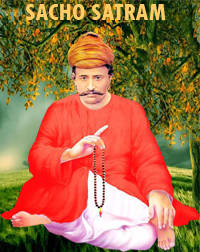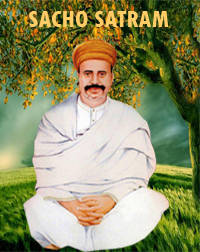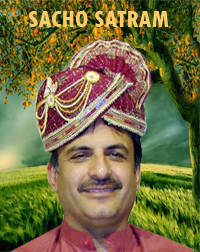On the auspicious Thursday dedicated to Naam Dhyan (17th October 2024), Hazir Swaroop Sai Sadhram Saheb delivered an enlightening divine satsang, emphasizing the significance of Naam. He shared that Shahanshah Satguru Sai Satramdas Saheb’s birth was extraordinary, as his life’s journey began with the essence of Naam.
This is truly a rare example of a saint who, after taking birth, refrained from consuming anything and, through his divine message, drew everyone’s attention to the practice of Simran. In the present era of Kalyug, his guidance holds profound significance.
Kal signifies restlessness, quarrels, tension, and intolerance, reflecting an era marked by constant agitation and conflict. It is a time for self-reflection and personal growth. Every era comes with its own unique principles and teachings.
Saijan explained that during Satya Yug, Devtas and Danavs lived separately, with Devtas residing in Swarg and Danavs in another Lok. In Treta Yug, both began living on Earth but remained in distinct regions, managing their respective territories. For instance, Ram ruled his kingdom, while Ravan governed his own. While Satya Yug was characterised by separate Lokas, Treta Yug was marked by distinct kingdoms
In Dwapar Yug, Devtas and Danavs began coexisting. For example, Krishna and Kans (uncle and nephew) lived in the same era, as did Yudhishthir and Duryodhan. They all shared the same environment, even residing under one roof at times
Then came Kal Yug, the era we are currently living in. In this age, both good and bad coexist within us. Within each of us lies goodness and badness, enmity and friendship, as well as positive and negative thoughts
We engage in both good and bad deeds, performing acts of virtue (Punya) as well as sin (Paap). Within us exist both strengths and weaknesses. Everything resides within us, and we are a reflection of what we carry inside
That is why it is essential to take charge of ourselves. Our thoughts have the power to change at any moment when we make an effort to manage and guide them
For instance, there are times when we hold a very positive impression of a friend, seeing them as loving, trustworthy, caring, and honest. But suddenly, our perspective shifts, and we begin to see that same friend as dishonest, ill-mannered, the source of our worries, and intolerable. We may even think that our life would be much happier without them.
Similarly, this shift can happen within ourselves. At one moment, we believe we are unparalleled—pious, talented, and the best version of ourselves. Yet, not long after, we may start thinking the exact opposite, cursing and blaming ourselves, feeling that no one is as flawed or ill-mannered as we are.
Our thoughts change rapidly, swinging between extremes. At times, we are filled with love, and at others, overwhelmed by hatred
Everything within us changes rapidly because both the divine (Dev) and the demonic (Danav) forces coexist within us
To control the rapid fluctuations of our thoughts, we need a powerful Mantra. Only a strong Mantra has the ability to steady and regulate our swiftly changing thoughts.
If we study Satya Yug, we learn that people would perform Tapasya (austerities) for thousands of years before receiving any rewards. In Treta Yug, after performing countless Yagyas, people would attain what they desired. In Dwapar Yug, the focus shifted to Daan (charity) and Punya (virtue)
And in Kal Yug, Saijan emphasised that it is Naam Adhar. Kal Yug is centred around Naam
In Kalyug, Naam Jaap and Simran are the key to improving our live
In Kal Yug, doing Naam Jaap protects and nurtures our life. Therefore, it is essential to dedicate some time each day to stay connected with Naam Jaap and the blessings of Satguru Sai
The significance of Kal Yug is greater than all the other Yugs, as it is through regular Naam Jaap and Simran that we can reach the highest levels of divinity in our lives.
To explain the importance and value of Naam Jaap and Simran, Hazir Swaroop Sai Sadhram Saheb shared a Katha
He said that once a man, who was tall, dark, and appeared unusual, came to the palace of Yudhishthir. The man asked Yudhishthir if he could ask a question, and Yudhishthir permitted him to do so
The man, looking strange and bewildered, asked Yudhishthir about an experience he had while approaching the palace. He explained that as he was walking, he suddenly felt as though the peak of a massive mountain was falling toward him, which terrified him. However, when he quickly moved aside and looked up, he saw that the mountain peak, which had been falling, had stopped abruptly. A very thin thread, perhaps even thinner than a hair, emerged from the mountain and was connected to its peak, preventing it from falling. He wondered how such an almost invisible thread could hold back the immense weight of the mountain peak
The moment the man asked Yudhishthir that question, Yudhishthir became furious and drew his sword to attack the strange-looking man. The man quickly started running out of the palace. Yudhishthir couldn’t catch him, as the man was incredibly fast and managed to escape
Everyone in the palace was astonished by Yudhishthir’s behavior. His brothers asked him why he had become so angry and wanted to attack the strange-looking man. Furious and enraged, Yudhishthir demanded to know who had allowed that strange-looking man into the palace
Bhim explained that the man had approached him and all the other brothers. When they asked him the purpose of his visit, he told each of them that he wanted to ask a question, and anyone interested could answer. However, when no one could answer his questions, each brother allowed him to go to the King for the answers
Sahdev said that when he asked the man which question he wanted to ask the King, the strange-looking man replied that while he was on his way, he saw a lady filling a bucket of water from a well. From that one bucket, she filled seven more buckets. But then, the same lady began filling that one empty bucket with water from the seven filled buckets. The man was surprised to see that all seven buckets of water could not fill the original bucket from which all the seven other buckets were filled.
The man expressed his confusion, wondering how one single bucket of water could fill seven buckets, yet those seven buckets couldn’t fill just the one bucket from which they had all been filled. Sahdev said he was also confused and asked the man to go ahead and meet the King for the answer.
Nakul told Yudhishthir that the strange-looking man had also met him. When Nakul asked him why he wanted to meet the King, the man replied that he wanted to ask a question that even Nakul could answer. He then told Nakul that while coming here, he saw a farm that was fenced for its protection. However, he noticed that the very fence was causing damage to the farm. He wanted to understand how a protector could also be a destroyer. Since Nakul did not know the answer, he too allowed the man to meet the King, knowing that only Yudhishthir could provide the answer
Arjun also came forward and told King Yudhishthir that he too had asked the strange-looking man why he wanted to meet the King. The man replied that he wanted to ask a question that anyone could answer. He then shared that while he was on his way, he saw a cow and its calf. What amazed him was that the cow was drinking the calf’s milk, which seemed strange to him. He wanted to ask the King why the calf was not drinking the mother cow’s milk, but instead, the cow was drinking the calf’s milk. Upon hearing this, Arjun told Yudhishthir that he, too, had allowed the man to meet the King, as he did not know the answer.
Bhim also told Yudhishthir that the mysterious man had met him as well. When Bhim asked the reason for his visit, the man replied that he wanted to ask a question and if Bhim could answer it. Bhim asked him what the question was. The man said that while on his way, he saw a very beautiful bird. Its beauty was unique, its chirping was refreshing and sweet, and all the universal knowledge and mantras were written on its wings. Looking at the bird gave him so much peace, but then he saw the bird started eating trash, junk, and rubbish. The man said he wanted to know why such a beautiful bird would be eating stinking waste.
Bhim replied that he didn’t know the answer and asked the man to go ahead and ask the King about it’
After listening to his brothers, King Yudhishthir became worried, and everyone asked him about the reason for his distress. Yudhishthir angrily said that the man, who looked strange and weird, had cleverly deceived everyone by telling them stories and had entered the palace, crossing all the security doors. Everyone looked at Yudhishthir’s agitation and asked him why he was behaving this way and who that man was
Yudhishthir explained that it was Kalyug, here to announce the arrival of its era and the profound changes it would bring. He said that all the events the man had mentioned were already unfolding in this era, and his purpose was to declare Kalyug’s presence.
Everyone asked Yudhishthir to explain the meaning of the stories the strange-looking man had told them.
Yudhishthir replied that the first story, about the water in seven buckets that could not fill one bucket, symbolised the situation in Kalyug. In this era, a father will work hard to make all his children smart, educate them, provide them with comforts, and help them become independent. However, once the children grow up and become self-sufficient, they will fail to take care of their father and neglect their responsibilities toward him. While the children will have well-furnished rooms, the father’s room will be poorly maintained. The one who gave them every comfort will receive minimal care in return, and no one will heed his needs.
As the time comes when no one listens to their father, and may even refuse to keep him with them, they will lose the blessings of the father. When children misbehave with their elders and fail to receive their blessings, they will never find true happiness. Therefore, the first sign of Kalyug will be that elders will stop receiving the respect they deserve from their children.
Yudhishthir further explained that the second story, about the fencing built to protect the farm but which ultimately destroys it, symbolised the situation in Kalyug. In this era, those in higher positions, elected by the people, will misuse their power. Instead of protecting and guiding those under their care, they will exploit and manipulate the system for their own gain. The protectors will become the destroyers. The systems of law will collapse, and those who seek protection from those in authority will be deceived. Yudhishthir clarified that Kalyug signifies an era without law, a lawless time. When there is no law and no trust among people, society will be plagued by tension, mental stress, and anxiety, with no one experiencing true contentment.
The third story, about the cow drinking its calf’s milk, symbolised that in Kalyug, the elders who are responsible for instilling good manners, etiquettes, cultural, and family values, and teaching their children about dignity, human values, and the consequences of wrong deeds—will fail in their duties. In Kalyug, everything will be the opposite, with unethical behaviour prevailing. People will become consumed by greed for materialistic things, and money will be the highest form of respect. To acquire wealth, individuals will resort to wrong and heinous actions, disregarding respect and values. There will be a loss of mutual respect, and at the cost of discipline, dignity, and honor, people will lead lives full of disrespect.
People will become ungrateful, shameless, indecent, and undignified. The elders will neglect their responsibility to teach good values to their children, instead living off money earned through dishonesty, deceit, and unlawful means, all while abandoning dignity and integrity.
When respect, dignity, and honesty are lost, humanity itself will come to an end.
Yudhishthir finally explained the meaning of the fourth story narrated by Kalyug. Like the beautiful bird, whose wings were adorned with mantras and scriptures, whose appearance was captivating and whose chirping was melodious, people in Kalyug will appear sweet and charming. They will be intelligent, compassionate, and generous, showing love and care to others. However, when they see an opportunity to gain personal benefit from others or situations, they will resort to deceit and inappropriate means to take advantage. They will become selfish, insensitive, greedy, and thoughtless. For the sake of their own selfish gains, they will abandon all knowledge, kindness, mindfulness, and care, revealing their true nature of cheating, selfishness, and ungratefulness.
People will betray each other behind their backs. They will speak of grand ideals but fail to act on them. They will appear great in words, but in reality, they will sink to the lowest levels.
Yudhishthir said that when respect for elders fades, and there is no peace but only agitation everywhere, when mutual respect is lost and loyalty vanishes, when people become dishonest, then, like the massive peak of an enormous mountain, the weight of our wrong deeds, bad karmas, and suffering will fall upon us. Everyone will be deeply affected by their own misdeeds, causing internal damage and turmoil.
Mountains of hardship, challenges, and suffering will overwhelm us.
At that moment, Yudhishthir explained that the Kalyug, which had come to inform us in the form of a strange man, had also conveyed through his story about the almost invisible thread, thinner than a hair yet strong enough to hold back the mountain peak, that it symbolised the power of Naam. He revealed that during times of misery, stress, and confusion, only the power of Naam Jaap would provide support to those who practiced it regularly. With the strength of Naam Jaap, people would be able to break free from the grip of the harsh and challenging environment.
People will receive the blessings of Parmatma when they silently and inwardly chant the sacred Naam, and practice Dhyan and Simran.
When people sit in Dhyan, they will be able to overcome their shortcomings and insecurities. They will be uplifted, filled with spiritual values, and attain the highest level of humanity.
When people receive the blessings of Parmatma and embrace higher spiritual values, Kalyug, in the form of the strange-looking man, announced that such individuals would be unaffected by the era of Kalyug. They would remain shielded from its negative impact.
The people who engage in Naam Jaap will also show respect to their elders, uphold good conduct, manners, and etiquettes, and maintain their dignity. Whatever they say will come to fruition, and with the values of Naam, Dhyan, and Simran, they will remain unaffected by the influence of Kalyug. Instead, they will attain oneness with their Satguru and Parmatma.
That is why it is said that the only support in Kalyug is the support of NAAM (Kalyug Keval Naam Adhar). In Kalyug, Naam will be the sole protector, shielding us from difficulties and sins, and sustaining us. Even when people endure the heat of hardships, the power of Naam will protect them, offering comfort and coolness under its shadow.
Yudhishter explained that in Kalyug, Naam alone will support people.
After sharing the beautiful story about the advent of Kalyug, Hazir Swaroop Sai Sadhram Saheb drew the people’s attention to the sacred life of Shahanshah Satguru Sant Sai Satramdas Saheb. He highlighted that Sai Satramdas Saheb, born on October 25, 1866, during the auspicious Amrit Vella, refrained from accepting his mother’s milk or even a single crystal of rock candy for three consecutive days. Additionally, his father, Sant Sai Khotaram Saheb, observed a divine light ascending towards the earth. In response, he closed his eyes and entered into Samadhi for those three days to express his profound gratitude to Parmatma for allowing him to be a part of this divine event.
After three consecutive days in Samadhi, expressing his gratitude, when Sant Sai Khotaram Saheb opened his eyes, he was handed the child Sant Sai Satramdas Saheb. As both revered saints gazed into each other’s eyes, Sant Sai Satramdas Saheb received the sacred Naam from his father. He then conveyed the profound message that while people are born and indulge in material pleasures throughout their lives, the true purpose of human existence is to elevate our humanity and reach great spiritual heights, ultimately becoming one with Parmatma. This, he emphasized, is only possible in Kalyug with the support of the sacred Naam. With the unwavering strength of Naam, we must strive to achieve oneness with Parmatma.
Sant Sai Satramdas Saheb was born on 25th October 1866, but he chose to embrace life on Earth after receiving the sacred Naam Daan from his highly revered father, Sant Sai Khotaram Saheb, on 27th October 1866, the third day after his birth. He set a profound example of living a purposeful life by chanting the pious Naam. Through Naam, he transformed from an ordinary human being into a superior one, endowed with the divine wealth of Naam, which ultimately leads to eternal oneness with Parmatma.
Hazir Swaroop Sai Sadhram Saheb emphasised that our birth in human form marks the beginning of our journey, but as Shahanshah Sant Sai Satramdas Saheb said, a life truly worth living is one in which we strive for eternal oneness with the Divine.
By regularly chanting the pious Naam, we can ascend to the highest levels of divinity. Our miseries will transform into blessings, and the immense weight of the mountain, which could otherwise destroy us, will be held back by the power of Naam, shielding us like a protective shadow from the heat of distress.
Saijan said that when we face difficulties, sorrow, or suffering, we should sit in silence and, for a while, focus on our concerns, praying to Satguru to bless us so that we can be freed from our fears and worries. After some time, we will notice that our troubles begin to transform into happiness. With the blessings of Parmatma, when we begin practicing Nem once in the morning and again in the evening for half an hour, we will experience growth and prosperity in our lives, while improving ourselves.
Hazir Swaroop Sai Sadhram Saheb illuminated the truth that Naam is the only support in Kalyug.
That is why Shahanshah Satguru, by setting an example through his own life, imparted the message that we too should take the support of the Pious Naam to make our lives meaningful. Therefore, it is essential for us to take care of ourselves by reflecting inwardly, observing our actions, and chanting the sacred Naam, so that we may reach the highest spiritual heights and attain divinity.
Sacho Satram



